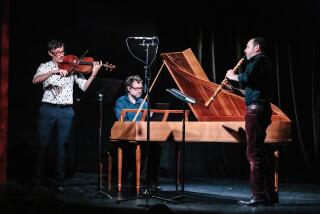There’s Always Room for Cellos
When Ron Carter comes to town, as he does this week, he carries with him one of the largest instruments in jazz, the stand-up bass. But this time, he’s bringing along something even larger, a Nonet.
Nonet? So what’s that--some kind of super bass?
Nope. It’s actually a nine-piece ensemble, not an instrument. And it’s a rare enough entity so that even its most rudimentary descriptive term sounds unfamiliar.
But nomenclature is no problem for Carter, who simply refers to the group that opens a weeklong run Tuesday night at Catalina Bar & Grill as his “Cello Band.” Which, of course, only raises further questions, since Carter is a preeminent jazz bassist--not a cellist. So what in the world of jazz is a “Cello Band”?
In the most basic terms, it’s as close as Carter can get to providing an orchestral sound for his compositional ambitions and still be able to pay the musicians.
“Having a very small--sometimes nonexistent--budget,” he explains, “I decided to find an ensemble that I could afford to write for, but that I still could get heard. A string quartet wasn’t exactly what I had in mind; it sounds so strident to me, so bright. But four cellos have almost the range of a string quartet with a whole lot more of the warmth of sound that I wanted.”
The nine-piece ensemble includes, in addition to the four cellos, a five-person rhythm section. It’s not the same instrumentation as a large orchestra, but it affords many of the same tonal options, while possessing the added benefit of an improvising, five-man jazz contingent of piano, drums, percussion and an additional bass (to provide backing for Carter’s soloing).
Few bass players have ever chosen to lead similarly larger-sized ensembles. With the notable exceptions of Oscar Pettiford, Charles Mingus and Charlie Haden, bassists--who usually have a proclivity to remain in the background--have generally elected to front trios, quartets and quintets.
But Carter, 59, a member of the classic Miles Davis group of the mid-’60s and a first-call jazz rhythm section bassist for decades, has had a long history of doing things his own way. Never content to be pigeonholed into one category, universally acclaimed for his diverse skills, he has played avant-garde jazz with Eric Dolphy and Don Ellis and performed with leaders as varied as Thelonious Monk, Bobby Timmons, Cannonball Adderley, Art Farmer, Jim Hall and dozens of others.
Yet he has never received the full recognition that his talents merit.
A bass player’s bass player, a musician’s musician, the tall, bearded veteran is a superb performer, adapting with grace and style to every situation. His rich, low tones--always precisely in tune--and his subtle, but imaginative soloing have set an impeccable standard on his instrument for decades.
What makes Carter’s work even more unusual is the compositional- like structuring that he brings to his accompaniments. Even a casual hearing of virtually any recording he has made will reveal little touches--a sustained tone here, a counter-phrase there--that add an unexpected layer of creativity.
No wonder he has been so motivated to establish the right ensemble voice for his own compositions.
“When you perform as a sideman,” Carter says, “playing in different sized groups, with different personalities and different musical directions, you kind of assemble all this stuff that you hear into your own head.”
And with performances on approximately 2,000 albums to his credit, Carter has had ample opportunities to be exposed to a variety of styles and attitudes.
“Then when you become the leader of a quartet, which is how I started out,” he continues, “the more competent your players are, the more sound you hear. And that eventually leads you to the realization that you can’t get the complete sound you want to hear out of just four people.”
But the process of maintaining a large ensemble is not easy, even for a musician-composer as experienced and admired as Carter.
Even so, he believes so strongly in the quality of his cello group that he is bringing it to Los Angeles from New York without benefit of record company support. Rather than use studio musicians who might lack the intensity and understanding of his scores that his regulars have, he is “spending a fortune” to perform with his full complement of familiar players. At the very least, he hopes, the weeklong run can serve as a showcase for his composing abilities that might result in some film scoring assignments.
Ironically, a performance by his cello band would receive far different treatment in Japan, where Carter reports he is the country’s second-best selling jazz artist (after Pat Metheny) and his recordings frequently appear on classical as well as jazz charts. He recently completed recording a program of his own takes on Bach’s “Brandenburg” Concerto No. 3 and works by Bartok, Ravel, etc., arranged for a 16-piece string orchestra, pianist Stephen Scott and himself on bass for the Toshiba company.
“I like to think,” Carter says, “that this is the way Bach, Bartok and the others would have written these works if they had had improvising musicians available to them.”
Although the recording was made in New York, Carter’s contract with Toshiba calls for a six-month window of exclusivity in Japan before it can be issued (on Blue Note) in the United States. So although it will be released next month in Japan, it will not be available here until the end of the year.
Carter reflects sardonically on the fact that despite his impressive accomplishments as an American jazz musician, his most enthusiastic fans are in Japan and Europe.
“I don’t know what the answer is,” he says, “why I can not only perform regularly and record in Japan, but they ask me to produce albums as well.
“In all the years I’ve been in the recording studio in the United States, I’ve only seen two African American producers in the control room. Yet I’ve produced about 12 records in Japan, largely because they trust my judgment. They give me a budget, they say, ‘We want you to record this artist within this time, with these tunes or whatever ones you can come up with that are equal to these.’ I get the job done, give them the master, and they’re completely happy with it.
“So why have I been unable to move in the same circles in the United States recording industry? Why haven’t they seen fit to allow me to go upstairs? It’s probably the same question Hank Aaron keeps asking himself at the Atlanta Braves.”
But for Carter, who has never hesitated to be upfront with his views about what he sees as the failure of the jazz record business to accept African American musicians anywhere other than in the studio, the question is not all that difficult to answer.
“It seems to me,” he says, “that the companies don’t trust African Americans to do anything but play. They assume, I guess, that we don’t have the capacity to make decisions off our instruments. But I can think of an armload of jazz musicians in New York who have the experience, the expertise, the vocabulary and the patience to go in the studio with a bunch of other musicians and produce a fine recording.”
Carter, who was born May 4, 1937, in Ferndale, Mich., started out on cello (which may be another reason for his choice of a cello quartet) before switching to bass. He received a bachelor’s degree from the Eastman School of Music in Rochester, N.Y., in 1959 and a master’s from the Manhattan School of Music in 1961. For the last 14 years, in addition to his heavy schedule of performing, he has been teaching private students and leading classes in courses including jazz ensemble and rhythm section at the City University of New York.
Like many players who stayed focused on the central elements of jazz throughout the rock, fusion and crossover years of the ‘70s and ‘80s, he refuses to subscribe to the point of view that jazz was on the verge of dying out prior to its revival by a new generation of “young lions.”
“I don’t agree with that at all,” he says. “Jazz has always been around. I don’t think that any single person revived it in the past 10 years because I don’t think it’s ever been dead. I’ve always worked, doing what I do.”
Nor does he, as an educator or a musician, feel comfortable with the retro trend, the fascination with the past, that has been fashionable with many young, emerging players in recent years.
“Jazz isn’t going to become a museum piece,” he says. “Not while there are players like Kenny Barron and Roland Hanna and Herbie Hancock around. They may not get the ink that somebody else gets, but they’ll always be pushing the envelope.
“Those kinds of players,” Carter says, “and I like to think I can count myself as one of them, are what jazz lives for. And we’re still around, rumors to the contrary.”
More to Read
The biggest entertainment stories
Get our big stories about Hollywood, film, television, music, arts, culture and more right in your inbox as soon as they publish.
You may occasionally receive promotional content from the Los Angeles Times.










